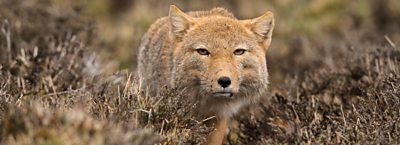The tropical, forested mountains of Southeast Asia are bursting with life. In the mountains of northern Thailand, within a vast limestone cave, there is a remarkable gathering. The world’s largest population of swifts are nesting, but hidden dangers lurk in the waters below – hungry catfish lie in wait, swallowing any birds unlucky enough to tumble into the water. But one swift won’t go down without a fight.
The forested slopes of Borneo’s Mount Kinabalu are home to the mountain tree shrew, a hungry creature that has an extraordinary relationship with the pitcher plants that grow here. The shrew licks nectar from the pitcher’s lid, and in return leaves a deposit of dung – food for the plant.
In India lie some of Asia’s most densely populated mountains - the Western Ghats. Here, Asian elephants are adapting to life alongside humans as they roam tea plantations. The elephants don’t eat the tea – it’s too bitter. Instead, they act as gardeners pulling up weeds from in between the tea bushes. These are also mountaineering elephants, and they sometimes climb to peaks above the clouds.
In the far west of Asia, away from the Tropics, stand the continent’s hottest and driest mountains: those of the Arabian Peninsula, in Oman. Here, an incredible transformation briefly takes place each year as fog sweeps inland and rocky slopes transform into green meadows brimming with life.
Asia’s toughest mountains are those that stretch for thousands of miles across the centre of the continent: the Himalaya. At the western edge of the range, in Pakistan’s Hindu Kush, the cliffs play host to an unparalleled battle. Markhor, the world’s largest species of goat, fight for the right to mate, teetering on the edge of perilous drops.
Nepal lies at the heart of the Himalaya, and is home to eight of the of the world’s ten highest mountains. Forested lower slopes provide a home for one of Asia’s shyest mammals, the red panda. Although almost entirely reliant on bamboo, a female searches for kiwi fruit to help get her through the long winter months.
In the eastern Himalaya, spring heralds the arrival of new babies for a troop of Yunnan snub-nosed monkeys, one of the world’s rarest primates. The young ones have a lot to learn about life in China’s remote and isolated Hengduan Mountains. It seems that the secret to survival is friendship – monkeys that huddle together stand a much better chance of beating the cold conditions.
Life in the Himalaya has always been tough, but now these mountains are changing. When temperatures rise, ice vanishes and the meltwater that people depend on is dwindling. In one remote village of Nepal inhabitants have left and only a handful of people remain.
Despite the challenges, the remotest corners of the Himalaya are home to one of Asia’s most iconic animals. Snow leopards are rarely found below three thousand metres, and wander alone over vast distances. But now, a hopeful male may have found a perfect mate – and after days of courtship, they pair up.
- Watch all episodes of Asia on �鶹�� iPlayer from and add to your Watchlist now
- Watch Asia, episode two - Above the Clouds on �鶹�� One on Sunday 10 November
FS
Filming locations
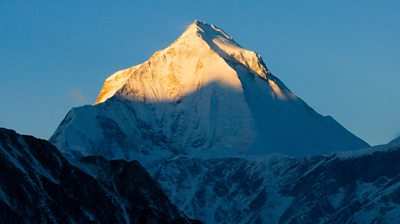
Everest scenic: Himalayas, Nepal
Cave swifts: Tham Nam Lod cave, Daen Lao Mountains, Thailand
Pitcher plant and shrew: Mount Kinabalu, Borneo
Tea plantation elephants: Valparai & surrounding regions, Western Ghats, India
Oman oasis: Dhofar Mountains and surrounding areas, Oman
Markhor rut: Chitral Gol National Park, Hindu Kush Mountains, Pakistan
Snub-nosed monkeys: Baima Mountain Reserve, Hengduan Mountains, Yunnan, China
Tibetan fox hunting: Shanglaxiu village, Tibetan Plateau, China
Deserted Himalayan village: Samdzong village, Upper Mustang, Nepal
Snow leopards: Kibber, Himachal Pradesh, Indian Himalaya
Interesting facts
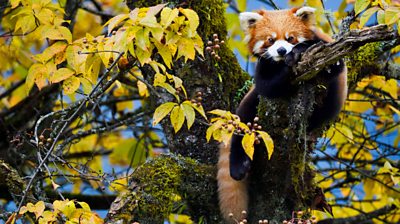
- The team were subject to a constant shower of swift droppings whilst filming so the team were sourced a collection of umbrella hats. Fashion aside, they did a wonderful job of keeping everyone relatively clean.
- A team of twenty seasoned local trackers and guides were enlisted to help the crew find red pandas to film. The red panda is an elusive creature shrouded in mystery, notoriously difficult to find.
- Tibetan foxes use yaks to help them hunt pika.
Filming feats
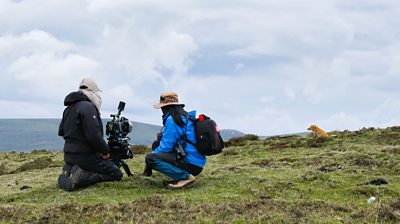
- This is the first time cave swifts being predated by fish has been filmed for a �鶹�� landmark series. This is thought to be the largest colony of any swift species on Earth.
- Thanks to Camera Operator Jacky Poon’s unique relationship with the female fox built up over four years, the team were able to capture intimate footage of Tibetan foxes.
- This is the first time wild markhor behaviour has been filmed with drones for a �鶹�� natural history landmark documentary.
- The first time a �鶹�� natural history landmark crew has filmed and followed a mating pair of snow leopards for four days.
Behind the scenes
- The team filmed Everest using gimbal-stabilised cameras mounted on helicopters. The gimbals allow for perfectly smooth images.
- For showing the Dhofar mountains’ detailed seasonal change, the team left their cameras on-location, which captured a gradual timelapse over four months.
Q&A with Sara Douglas (Producer of Above the Clouds)
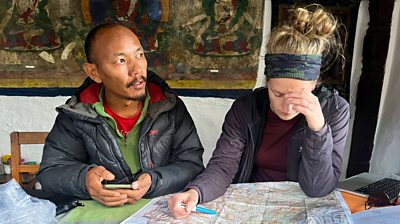
Do you have a favourite sequence from your episode?
It's definitely a close call between a couple, but if I had to pick just one, it would probably be the Tibetan fox sequence. I just really love the story. I also love the fact that Jacky Poon, the cameraman, had been going back to the same place for multiple years to film this same female fox and had seemingly developed this relationship and this unique trust with her.
So I loved that right from the start. And I thought, “This is pretty special, anyway, but the fact that he has that connection with the fox could be a really great opportunity for us.” Obviously, the Tibetan plateau is also an amazing place. It's just so vast and wild and breathtaking. It's got that savage beauty. So I was keen to include it in the film.
Tell us more.
When I was chatting to Jacky back in the early days, he was telling me about all kinds of interesting things that he'd seen her do. I was trying to dive into the depths of what different behaviours he'd witnessed, and he started talking about this yak. Seemingly the fox uses the domestic yak as cover to help her with her hunting. He was quite excited about it. It was something he had tried to film before, but he’d never quite managed to capture it. So that felt like the story that we wanted to go for.
What happened next?
Every time we chatted, I pushed the bar higher. Towards the end of the shoot, I was saying to Jacky, “Be amazing! If you could get a shot like that, almost like you are directing a drama, it would be incredible.” He replied, “Oh, this will be really hard, but I'll see what we can do”. And then we chatted the next day, and he said, “Oh, we got it!” He delivered. It's just one of those shoots where all the stars aligned, and it all came together in the end.
Jacky’s connection with the fox is moving, too, isn’t it?
Yes. I think there's something relatable about it as well for anybody who's a dog owner because the fox is obviously a canine. I know that Jacky's a dog owner and I'm a dog owner, and that love which people really have for their dogs is something that we talked about. So I think that very relatable connection is there as well.
Which other sequences stand out for you?
I also really like the cave swift sequence. I really was keen to start the film with something slightly unexpected. When people think of mountains in Asia, they might just think of the Himalayas and high-altitude barren mountains with not necessarily lots of life. But the Himalayas are a very specific type of mountain, and in fact, there are very different kinds of mountains in almost every corner of Asia. So I wanted to go to one of those different locations and showcase something different. I felt like starting in a cave inside a mountain in Southeast Asia would be something a bit surprising.
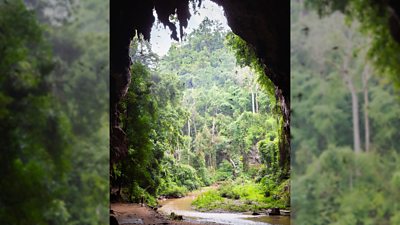
The process of filming that sequence was pretty extraordinary, wasn’t it?
Yes. We had to hike in to get to the cave in northern Thailand. One of the first things that you would notice before you could even see the cave was the smell. There are over a quarter of a million swifts living in there. But there's also a huge population of bats. When you come around the corner towards the cave, the next thing you notice is the noise. The noise of all those birds, and the noise of the bats, which is high pitched and squeaking, is just continuous.
Then if you combine those two things with the fact that it's over 30 degrees and really humid, you realise it’s a sensory overload being in that cave. And then once you're working in the cave, poo is constantly raining down on you. I can imagine people thinking, “Why was this sequence one of your favourites, then?” But I quite enjoy overcoming those challenges and thinking, “Yes, we're doing something that maybe not everyone would attempt to do because it's not very pleasant.”
How long were you in the cave for that shoot?
It took nearly a month in total to do the whole sequence, but because of that sensory overload, I was really conscious of making sure that no one spent too much time inside the cave. So I tagged teams in and out. They'd spend some time inside the cave, filming things like the nest, the falling behaviour, and the predation behaviour. But then they’d also get time to go out and do some drone filming and see daylight and breathe fresh air. But it was worth it. It’s a great sequence to open the episode.
Did you break new scientific ground with those scenes?
Yes. No one studies the extraordinary behaviour of the carp and catfish which eat the falling birds, and no one studies that ecosystem. I spent one day just standing watching the birds in the cave entrance. They would create this amazing formation. There were two masses of birds next to each other. One lot would come into the cave and circle around.
Then they'd tag the next group to enter the cave and disappear off to their nests. It was like a Heathrow holding pattern. Just watching how they coordinated coming in and out of the cave without ever hitting each other was amazing. They seemed to have this organization which I didn't understand. I remember standing there thinking, “If I was an ornithologist, I'd love to come and study all of this.”
Tell us more.
Actually, off the back of the shoot we were in contact with a lot of different swift scientists from around the world because this behaviour hadn't been seen before. I'm hoping that one scientist now has taken up the idea of trying to analyse some of the 100 hours of footage. They're going to go through it and see if there is something they can extract from it that might be useful from a scientific perspective. Our filming is always informed by the science. So it's just very nice to give something back that might be
